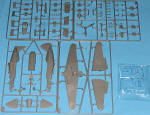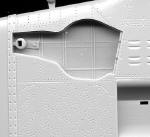
Trumpeter 1/48 MiG-3 (early)
| KIT: | Trumpeter 1/48 MiG-3 (early) |
| KIT #: | ? |
| PRICE: | $24.95 MSRP |
| DECALS: | Three Options |
| REVIEWER: | Scott Van Aken |
| NOTES: | New mold kit |

| HISTORY |
Operational History:
The first production MiG-3 rolled off the assembly line on December 20, 1940. By March 1941, 10 of these aircraft were coming off the production line every day. It was not long before the type would see combat, claiming a pair of German Junkers Ju 86 reconnaissance aircraft even before the start of hostilities between Germany and the Soviet Union.
By the time of Operation Barbarossa, over 1,200 MiG-3's had been delivered.
During initial testing of production aircraft was found to be inferior to the MiG-1 due to its weight increase, and fuel consumption was well over what Mikoyan and Gurevich were promised by the manufacturer (zavod No.24), but the fuel consumption was actually found to be an issue with the testing of the aircraft and the failure to take into account altitude correction. Mikoyan and Gurevich went as far as arranging for two more flights between Leningrad and Moscow to prove the MiG-3 could fly 1000 km.
However that was not the end of the issues that the MiG-3 encountered during its deployment. Several MiG-3s produced were found to have unacceptable performance at altitude due to oil and fuel pressure. It was also found that pilots attempted to fly the MiG-3 as if it were an earlier aircraft (especially the forgiving Polikarpov I-15, I-153 and I-16's) and which led to several other problems. Soon new oil and fuel pumps were introduced as well as attempts at better pilot training to familiarize them with the MiG-3.
Over the next two years the MiG-3 several new changes made it into production, including up-gunning to UBS machine guns and ShVAK cannons.
Due to the conditions of battle with the German forces, the MiG-3 was forced into a low altitude and even a ground-attack role, but it was quickly found to be inferior, and withdrawn from this role. The death knell for the MiG-3 was the discontinuation of its AM-35 engine so that Mikulin could concentrate on AM-38 production for the Ilyushin Il-2 Shturmovik. It was eventually used as a reconnaissance plane-its high service ceiling of 40,000 ft and fast high altitude speed made well suited for such a role.
Even with the MiG-3's limitations, Alexander 'Sasha' Pokryshkin, the second leading Soviet ace of the war with 59 official victories, recorded most of those victories while flying a MiG-3.
| THE KIT |
 We
all knew it was just a matter of time before we'd see a small scale MiG-3 from
Trumpeter. Their 1/32 scale kit sold well and so it seemed a natural. I doubt if
we will see this in 1/72 from Trumpeter, thanks to the HobbyBoss snap kit, and
that would be a pity.
We
all knew it was just a matter of time before we'd see a small scale MiG-3 from
Trumpeter. Their 1/32 scale kit sold well and so it seemed a natural. I doubt if
we will see this in 1/72 from Trumpeter, thanks to the HobbyBoss snap kit, and
that would be a pity.
The kit comes in Trumpeter's usual sturdy box with four
poly bags holding five sprues. One of my polybags was not sealed, as if someone
had replaced the sprue within (the wings). The clear parts are well done and
clear enough for most tastes. It has a
 separate
canopy from the windscreen and backlight. Detailing is quite good with crisply
done engravings and rivet detail. Those who don't like the current crop of
recesses rivet detailing probably won't like this, but to me, it doesn't look
terribly overdone at all. You be the judge.
separate
canopy from the windscreen and backlight. Detailing is quite good with crisply
done engravings and rivet detail. Those who don't like the current crop of
recesses rivet detailing probably won't like this, but to me, it doesn't look
terribly overdone at all. You be the judge.
The rest of the kit is equally as well detailed. There were not sink areas or nasty ejector pin marks readily found and no flash. I have to admit that I'm not that jazzed about the fabric control surface detailing as it seems a bit stark for my tastes. However, I'm sure it is accurate as it certainly looks convincing. I was going to say that the only real option was for underwing rockets, but since the holes are already drilled, I guess that option was taken away. I'd have rather had the holes filled and been provided the opportunity to drill them out if I wanted wing rockets. As it is, to do one without them will require filler and sanding.
![]() I
was particularly impressed with the detail level on the inside consoles and the
floor. While I'm sure that resin replacements will be around later to add even
more depth, what the kit gives you is quite nice as it is. No harness is
provided so you'll have the opportunity to add your own from photo etch or tape
if you wish. A nice radio rack is provided for behind the seat, though little
will be seen of it when you close the fuselage halves. The wing root intakes are
inserts that have full intakes, so no worries about having edges to try to fix.
The kit also provides separate flaps and
I
was particularly impressed with the detail level on the inside consoles and the
floor. While I'm sure that resin replacements will be around later to add even
more depth, what the kit gives you is quite nice as it is. No harness is
provided so you'll have the opportunity to add your own from photo etch or tape
if you wish. A nice radio rack is provided for behind the seat, though little
will be seen of it when you close the fuselage halves. The wing root intakes are
inserts that have full intakes, so no worries about having edges to try to fix.
The kit also provides separate flaps and
 ailerons,
but I get the impression that these are designed to be cemented in the neutral
position. The upper flap wells, for example, are rife with ejector pin marks and
have no detail. Same for the inside of the separate flap pieces.
ailerons,
but I get the impression that these are designed to be cemented in the neutral
position. The upper flap wells, for example, are rife with ejector pin marks and
have no detail. Same for the inside of the separate flap pieces.
Instructions are standard Trumpeter with Gunze paint references and well drawn construction steps. There are markings for three planes. The box art plane is green upper, light blue lower and a black engine cowling. An all white one with the red forward spinner and arrow is another and the third is green upper and light blue lower with a yellow spinner. No unit information is given. As Trumpeter decals are not known as the best around, aren't you glad you bought those Aeromaster sheets you never used on your CA and ICM kits? The kit decals are well printed and glossy. You never know, these might actually work out well.
| CONCLUSIONS |
So there you have it. An inexpensive MiG-3. I'd say that this makes the ICM and Classic Airfames kits pretty well dinosaurs when it comes to this aircraft so you might want to pawn yours off to have the loot to buy this one. It looks like it will build into a nice model and I like it so much that I'm going to give it a go. Stay tuned.
| REFERENCES |
October 2007
My thanks to those who owed me money for being able to splurge on this one.
If you would like your product reviewed fairly and quickly, please contact me or see other details in the Note to Contributors.